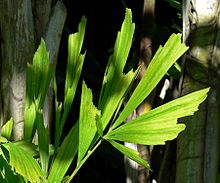Caryota mitis
Appearance
| Caryota mitis | |
|---|---|

| |
| Leaves of Caryota mitis | |
| Scientific classification | |
| Kingdom: | |
| (unranked): | |
| (unranked): | |
| (unranked): | |
| Order: | |
| Family: | |
| Genus: | |
| Species: | C. mitis
|
| Binomial name | |
| Caryota mitis Lour.
| |
| Synonyms[1] | |
| |
Caryota mitis, the clustering fishtail palm, is a species of palm native to southeast Asia from India to Java to southern China, now sparingly naturalized in southern Florida and in parts of Africa and Latin America.[2][3][4][5][6] The species was originally described from Vietnam in 1790.[7] In Florida, it grows in hummocks and in disturbed wooded areas.[8]
Caryota mitis has clustered stems up to 10 m (33 feet) tall and 15 cm (6 inches) in diameter. Leaves can be up to 3 m (10 feet) long. Flowers are purple, fruits dark purple or red.[7][9][10]

References
- ^ The Plant List
- ^ Berendsohn, W.G., A. K. Gruber & J. A. Monterrosa Salomón. 2012. Nova Silva Cuscatlanica. Árboles nativos e introducidos de El Salvador. Parte 2: Angiospermae – Familias M a P y Pteridophyta. Englera 29(2): 1–300.
- ^ Idárraga-Piedrahita, A., R. D. C. Ortiz, R. Callejas Posada & M. Merello. (eds.) 2011. Flora de Antioquia: Catálogo de las Plantas Vasculares 2: 9–939. Universidad de Antioquia, Medellín.
- ^ Linares, J. L. 2003 [2005]. Listado comentado de los árboles nativos y cultivados en la república de El Salvador. Ceiba 44(2): 105–268.
- ^ Molina Rosito, A. 1975. Enumeración de las plantas de Honduras. Ceiba 19(1): 1–118.
- ^ ORSTOM. 1988. List of Vascular Plants of Gabon with Synonymy, Herbier National du Gabon, Yaounde.
- ^ a b Loureiro, João de. Flora Cochinchinensis 2: 569–570. 1790.
- ^ Wunderlin, R. P. 1998. Guide to the Vascular Plants of Florida i–x, 1–806. University Press of Florida, Gainesville.
- ^ Flora of North America v 22 p 115.
- ^ Flora of China v 23 p 150.
